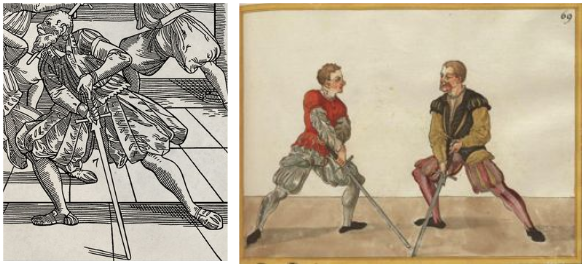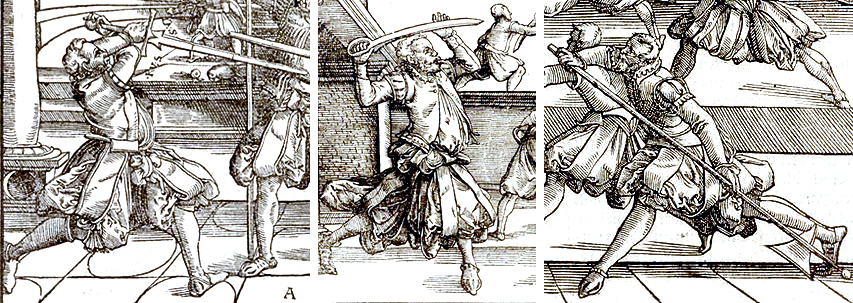Posture
Contents |
15th Century
...
16th Century
Meyer doesn't explicitly describe postures in his treatises though he provides numerous illustrations which illustrate general positions.
In order to maintain a fairly simple system the stances in Meyer can be broken down into three main types:
- Front weighted
- Rear weighted
- Cross stance
Front Weighted
The orthodox footwork for German sword arts. The fencer is ready to spring forward or to the side
Focus points:
- Lead foot faces toward the opponent
- Rear foot faces perpendicular to the opponent - the actual angle varies from slightly over 90 degrees, to 45 degrees or so.
- Feet are placed somewhat to opposite sides of a single axis.
- Feet are spaced around 3 of the fencer's own foot lengths apart.
- Head is held upright
- Pelvis is not overly tilted forward or back - no poking out of the backside!
- Spine maintains alignment with the hips and shoulders and leans slightly forward or is upright
- Alignment varies from directly toward the opponent, to turned 30 degrees toward the 'inside' (so if the left leg is forward at 12 o'clock, the hips are turned toward 1 o'clock).
The following images show examples of forward weighted stances:
Rear Weighted
This position is classically seen in the Zornhut guard.
The foot position is similar to the forward weighted posture, but facing in the opposite direction, and the fencer looks over their shoulder with their body is turned somewhat away from the opponent.
The body position is useful as an evasion leaning back, and provides a chambered position ready to strike with a powerful attack.
Focus points:
- Lead foot faces around 45 degrees toward the opponent - the actual angle varies somewhat.
- Rear foot can face directly away from the opponent or can be perpendicular to them.
- Feet are placed somewhat to opposite sides of a single axis.
- Head is turned to look over the lead shoulder.
- Pelvis is not overly tilted forward or back - no poking out of the backside!
- Spine maintains alignment with the hips and shoulders, and leans away from the opponent
- Alignment varies from directly perpendicular to the opponent, to turned 30 degrees toward the opponent (so if the left leg is forward at 12 o'clock the body is turned toward 5 o'clock
The following images show examples of backward weighted stances:
Cross Stance
This position is seen in many places in Meyer and is typically "Meyerish" in its look.
There are three main applications for this posture:
- From the front weighted posture the fencer can step through without changing the directly of the lead foot so the hips keep their alignment.
- Twisting the body in a strike or motion outward from the alignment of the fencer.
- Stepping across behind the lead leg with the rear from a front weighted posture so as to achieve a Triangle Step offline.
Focus points:
- Lead foot faces around 45 degrees toward the opponent and it is turned outward - the actual angle varies somewhat.
- Rear generally faces directly toward from the opponent and is on the ball of the foot.
- Feet are placed somewhat to opposite sides of a single axis.
- Head is held up and looks straight forward.
- Pelvis is not overly tilted forward or back - no poking out of the backside!
- Spine maintains alignment with the hips and shoulders, and is quite upright
- Alignment varies from directly toward the opponent, to turned 30 degrees toward the opponent toward the outside (so if the left leg is forward at 12 o'clock the body is turned toward 11 o'clock).


